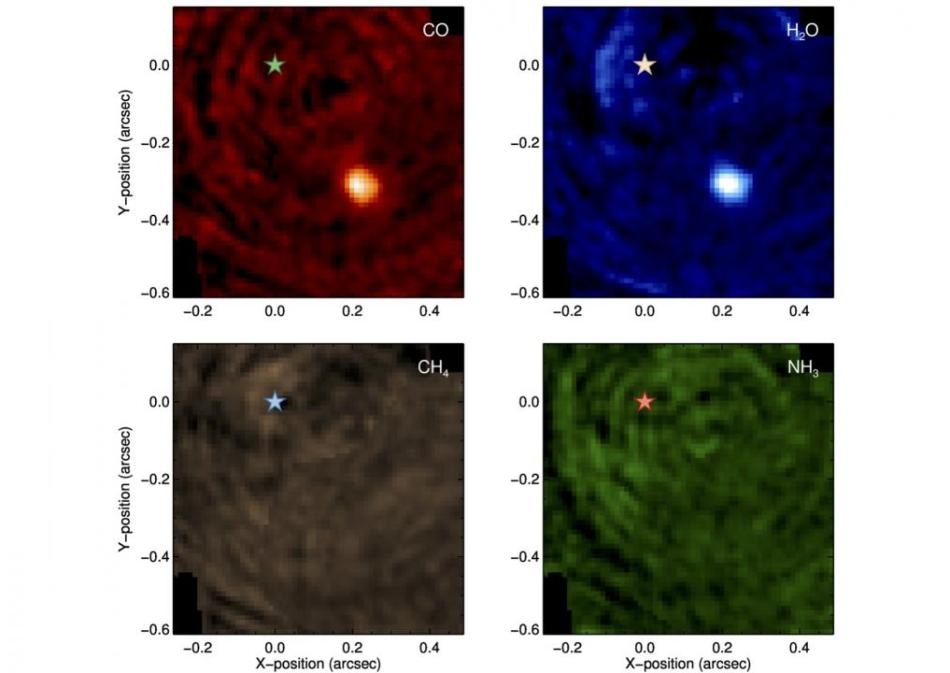Jun 21 2018
Similar to the way Earth revolves around the Sun, every exoplanet revolves around a star. Hence, in general, it is difficult to acquire images of an exoplanet, as the light of its star is highly dazzling. However, a group of astronomers, headed by a scientist from the University of Geneva (UNIGE) and member of NCCR PlanetS, conceptualized to detect specific molecules that exist in the atmosphere of the exoplanet to render it visible, as long as the same molecules are not present on its star.
 The planet becomes visible when looking for water or carbon monoxide molecules. However, as there is no methane nor ammonia in its atmosphere, it remains invisible when looking for these molecules, just as its host star which contains none of those four elements. (Image credit: University of Geneva)
The planet becomes visible when looking for water or carbon monoxide molecules. However, as there is no methane nor ammonia in its atmosphere, it remains invisible when looking for these molecules, just as its host star which contains none of those four elements. (Image credit: University of Geneva)
This novel method makes the device sensitive to only the selected molecules, rendering the star invisible and enabling the astronomers to directly observe the planet. The outcomes of the study have been reported in the Astronomy & Astrophysics journal.
To date, direct observation of the exoplanets discovered by astronomers was possible only very rarely, since they are mostly concealed by the tremendous luminous intensity of their stars. Only a handful of planets located quite far from their host stars can be differentiated on a picture, specifically with the help of the SPHERE instrument installed on the Very Large Telescope (VLT) in Chile, and similar instruments positioned in other places. Jens Hoeijmakers, researcher at the Astronomy Department of the Observatory of the Faculty of Science of the UNIGE and member of NCCR PlanetS, thought whether it would be feasible to trace the molecular composition of the planets.
“By focusing on molecules present only on the studied exoplanet that are absent from its host star, our technique would effectively ‘erase’ the star, leaving only the exoplanet,” he explained.
Erasing the Star, Thanks to Molecular Spectra
In order to investigate this innovative method, Jens Hoeijmakers and an international group of astronomers used archival images captured by the SINFONI instrument of the star beta pictoris, known to be orbited by a giant planet, beta pictoris b. Each pixel in the images includes the spectrum of light received by that pixel. Then, the astronomers compared the spectrum included in the pixel with a spectrum corresponding to a given molecule, for instance, water vapor, to observe whether there is a correlation. In case a correlation occurs, it indicates that the molecule exists in the planet’s atmosphere.
Jens Hoeijmakers applied this method to beta pictoris b and noticed that the planet became distinctively visible while looking for carbon monoxide (CO) and water (H2O). However, when the method was applied to ammonia (NH3) and methane (CH4), the planet remains invisible, suggesting the absence of these molecules in the atmosphere of beta pictoris b.
Molecules, New Planetary Thermometer
In all four situations, the host star beta pictoris was observed to be invisible. In fact, this star is exceptionally hot, and at higher temperatures, the four molecules are destroyed.
“This is why this technique allows us not only to detect elements on the surface of the planet, but also to sense the temperature which reigns there,” explained the astronomer of the UNIGE.
Hence, the certainty that it is not possible for astronomers to find beta pictoris b with the help of the spectra of ammonia and methane is consistent with a temperature evaluated at 1700 degrees for this planet, which is very high for the molecules to exist.
“This technique is only in its infancy,” stated Jens Hoeijmakers. “It should change the way planets and their atmospheres are characterized. We are very excited to see what it will give on future spectrographs like ERIS on the Very Large Telescope in Chile or HARMONI on the Extremely Large Telescope which will be inaugurated in 2025, also in Chile,” he concluded.